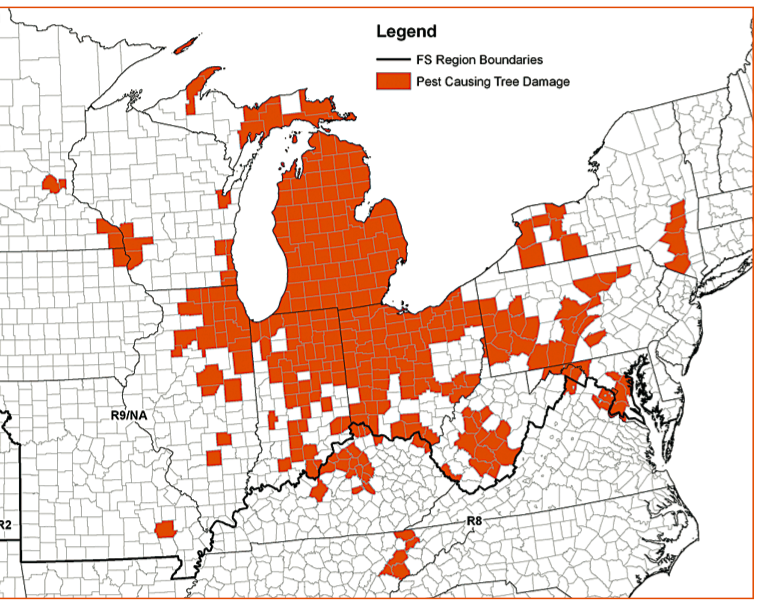
Emerald ash borer. Photo: U.S. Forest Service.
The threat from a metallic green beetle is quickly spreading throughout the ash trees of the Great Lakes region, despite a recent national report that said fewer trees died in 2011 from harmful insects in the U.S. than previous years.
The region’s drought can also seal the fate of sick and dying trees, the report said.
Many are already dropping leaves or starting to change color early this year — both mechanisms trees use to cope with drought, said Deborah McCullough, forest entomologist at Michigan State University. “It’s possible some insect populations could increase next summer as a result of this years’ drought, but that is just really hard to predict.”
Still, it doesn’t seem like emerald ash borers will be leaving the basin any time soon.
“Michigan has the worst infestation,” said Robert Mangold, associate deputy chief for research and development at the U.S. Forest Service. So bad in fact, that this year the agency stopped surveying the area for the invasive beetle.
“There’s limited funding to do those kinds of surveys,” said McCullough. “So they’re concentrating on the states that don’t have significant outbreaks yet.”
While western forests enjoy a decline in deadly pests like the mountain pine beetle, which harmed 3 million fewer acres in 2011 than the year before, the emerald ash borer continues to thrive in the east, the report said.
“The ash borer is the most destructive insect that’s ever invaded North America,” said McCullough. “It kills urban trees, landscape trees, forest trees and is affecting every species of ash in North America.”
As of 2011, the beetle had invaded all eight of the Great Lake states and the province of Ontario, according to the report.
“We’re trying to manage the pests but it just continues to spread,” said Mangold.

Every county in Michigan is now infected with the ash borer, Mangold said. Ohio reported four newly infected counties in 2011, totaling to 57 infected
counties out of 88. Newly infected counties were also reported in New York, Wisconsin, Minnesota and Pennsylvania, the report said.
“Conservatively there’s probably 80 million dead ash trees in the southern half of Michigan’s Lower Peninsula alone,” said McCullough.
Pesticide injections can save individual trees, but it’s not a realistic method to treat vast forests, and the pest has claimed a lot of trees in the Great Lakes already, Mangold said.
“It’s beyond eradication in most areas, especially in the Great Lakes,” he said. “We are working on biological controls and management techniques that tree farmers can use, but we are concerned about our ash resource.”
The ash borer spreads mostly by flying. But the Great Lakes are also particularly vulnerable because ash borers often hide in wood packing material used to stabilize vessel cargo, Mangold said. There are regulations that require using pesticides to kill the invasive bugs, but they aren’t foolproof.
“There’s so much trade coming in that sometimes things get through,” he said. The beetle can also spread by moving firewood or by traveling long distances with trees purchased from local nurseries.
The ash borer isn’t the only threat. Other insects like the butternut canker and the spruce budworm are gradually spreading in certain Great Lakes states as well, the report said.

Exit holes from emerald ash borer. Photo: U.S. Forest Service.
The good news is that while insects like the ash borer dominate the Great Lakes region, others like the gypsy moth have been rapidly decreasing. The moth defoliated less than 5,000 acres in 2011, compared with 1.2 million acres the year before, according to the report.
The significant decrease is likely a result of the successively wet springs of the past few years, Mangold said. The Forest Service also played a significant role. “We have a big intensive program called Slow the Spread along that advancing front, and that has slowed gypsy moths by about 60 percent the annual rate of progression,” Mangold said.
Watch this video for more information on emerald ash borer and other forest insects: